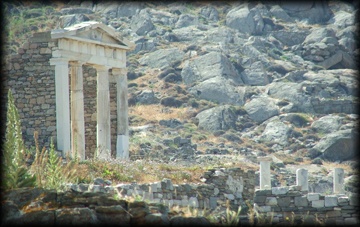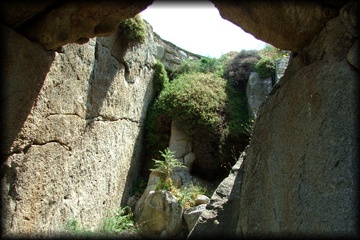The Land That Time Rememberedby Eric Francis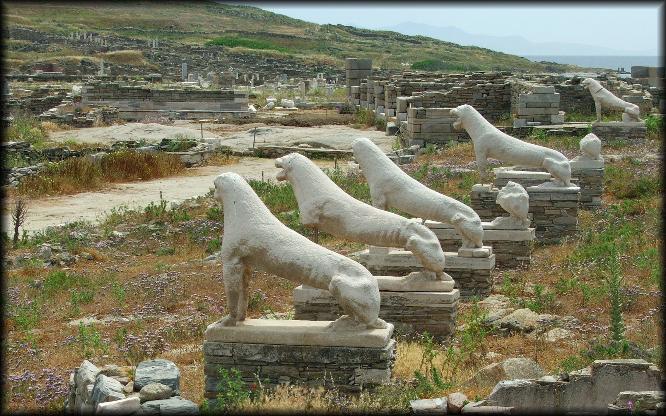
Lions have stood guard over the Sacred Lake, birthplace of Apollo and Artemis, on the island of Delos for some 2,500 years. Digital photo by Eric Francis. IT'S EASY TO THINK OF THE STORY of Apollo's birth on Delos as a way of explaining how a tiny island, blazing with sunlight, and made of rocks overrun with wildflowers and lots of really intense lizards, became for seven centuries a major cosmopolitan center of worship and trade on the Aegean Sea. The Greek myths always provide plausible explanations, in the form of old and psychologically astute stories, for why certain things is the way they be. So it was that the goddess Leto, pregnant with twins sired by Zeus, was searching out a place to give birth. Fearing the wrath of Hera, queen of heaven and Zeus's wife, no island would have her. Leto pleaded with the Delians, whose poor island drifted around the Aegean and provided its inhabitants with little to eat. She said that if these twins were born there, then people would come from all over to offer sacrifices, providing more food than they could ever need. Hera, consumed with her jealousy, tried to mess with the birth by delaying the arrival of her daughter Eileitheya, midwife of the gods. For nine days Leto labored until Eiletheya's arrival. Finally, grabbing hold of a huge palm tree and squatting (she had a good midwife -- humans, or human goddesses for that matter, were not meant to birth laying on their backs), Artemis, goddess of the Moon, of light and of the hunt was born; and then came Apollo, god of the Sun, of light and of divination. This was at a place on the island called the Sacred Lake -- where, in Greek mythology, the Sun first shined. And where it shines today; visiting Delos, I spent an hour in the Sacred Lake (now grown over with grass). It's an ocean of prana. "It is a well known fact that the sunlight over Delos is of even greater brightness and penetrating clarity than that of the other Sun-drenched islands of the Cyclades," says a dependable little book by Nico Vrissimtzis, a monk, historian and sociologist who by special permission sometimes lives on the mostly uninhabited island. Leto knew what she was talking about. Great pillars were set down to anchor the island to the bottom of the sea, so it no longer floated about randomly; now people could find it. Sanctuaries to Apollo were indeed built, and to Aretmis, and to Leto herself, and even to Hera, as a conciliatory gesture. The visitors poured in. Many temples and cults and sects sprung up. Eventually, most of the Greek pantheon had a home there, with temples built to honor Hermes, Aphrodite, Poseidon, Dionysus, and many others -- remnants of which all stand today. Delos became the Greek's version of Mecca. Reading the histories, it seems that anyone who could afford to would make the trip. What is today called the 'ancient harbor', where tourist ferries still come and go 20 or so times daily, must have been quite a busy place. "By the 7th century B.C., Delos had become chief religious sanctuary of the Ionians and magnificent religious observations and festivals took place on a regular basis," Vrissimtzis writes. The Ionians, migrants and great traders associated with the Persians, were apparently the first Greek-speaking people to reach mainland Greece. As my teacher Arthur Joseph once spent an entire conversation impressing upon me, there actually is a first time for everything. Later, Delos was the capital and treasury of a maritime league (the Delian Confederacy, or the First Athenian Confederacy). It was high civilization by any standard, ancient or modern. The architecture that was home to this international culture includes water cisterns that collected rain, advanced sewerage systems, a theater that could seat 4,500, a stadium, a gymnasium, workshops, houses, mansions, paved marketplaces, a healing temple and much else. There were public and private banks. All of this evolved over a period of time at least triple the age of the United States, all before the birth of Jesus. This is difficult for us to understand, when Americans think of an old house as something with funky paneling from the 50s. As the centuries passed, there were many ups and downs; tyrants tried to have their way with the place; it changed hands a lot of times, and at certain times it was independent. In a 'purification' ordered by Athens, graves were dug up and dumped on a neighboring island; this also happened a second time. Around this time, being born or dying were banned from the island by greedy, manipulative bureaucrats in Athens who wanted more control -- a move designed to dissociate the community from its land. The sacred island gradually became more a center of trade than a primarily religious spot. But it was nobody's homeland, as after a time no one was born there, and no ancestors were buried there. Still, the place thrived onward. Delos is said to have been the first truly cosmopolitan port in Europe. Everything from grain to slaves were sold on the island -- apparently, many, many slaves; and it was like a vast wholesale food market for the whole region. In the process, religions from many cultures were made welcome; there were temples to Syrian and Egyptian deities. There's also one of the first synagogues outside the holy lands around Jerusalem. The Delos synagogue is widely considered the oldest original Jewish house of worship of the Diaspora, or scattering of the Jews. (According to one source, it's the oldest known synagogue anywhere.) People are into religion, so give them what they like. Make it personal. Of course, all the foreign gods and goddesses looked a little Greek, but that's how things were done.
Then, twice in the first century BCE, the place was sacked: attacked, mass murder committed, many taken into slavery. The first time was in 88 BCE by Mithridates, the emperor of the kingdom of the Black Sea. He was at war with Rome, and Delos was very important to Rome. It is said that twenty thousand people were killed in the assault, though this is likely to be an exaggeration. Still, it was not a good day. The second time was in 69 BCE, by the pirates of Athenodoros, allies of Mithridates, who trashed the island and took many into slavery. This did the island society in; it was no longer a safe haven. Combined with the fact that there were now other important ports in the developing European world, the second assault led the island to disappear into obscurity. The Greek emperor even put the place up for sale in the 1st century AD. Nobody would buy it. In later years, it was used as a marble quarry -- that is, the temples, monuments and mansions were basically stripped for their materials. At times it was a base for pirates. The Turks owned it for a while. Sometimes the locals would mine materials there, and historians say if it was inhabited, it was not by many. There was no land to farm and nothing to hunt. Delos was all but forgotten until French archeologists arrived in 1873 and, appreciating the importance of ancient Greek history, began a systematic excavation that is still underway. Delos is now considered the largest archeological site in all of Europe. None of this prepares you for what you experience going there. I heard the story of Delos, in summarized form, from a souvenir shopkeeper on the 4th of May, the eve of Beltane with the Sun approaching the midpoint of Taurus. I realized at that moment that going to Delos at this time was why I had come to Mykonos -- an island renowned for its discotheques, located just one nautical mile from Delos. The next morning, I was on the first ferry I could get. Half an hour later, I was standing with watering eyes and chills running through my body as our boat approached the ancient harbor, and I saw the ruins of the city spread across the landscape. I cannot say I had any actual past life memories. But I can tell you that the sense of familiarity was overwhelming. To see the place for the first time was to see it again, and I thought: so this is what happened to you. After deciding not to deal with an archeologically trained, $130 per hour private tour guide after she threw a cigarette butt on the ground, I wandered the place alone in astonishment. I could practically hear the sounds of life echoing in the passageways, I could feel the stories, the love, the challenges of living, the sense of how good life was in this prosperous place, and all the many experiences of those lives fading to memory. I knew the people, and could feel their encounters. I could sense, for a moment, that civilizations really do arise and disappear. For a moment, I touched the inspiration of J.R.R. Tolkien, who records many such histories in The Silmarillion -- his tales of the elves -- and Akallabeth -- his history of Numenor (or Atlantis), from which Strider is descended. I was led decisively through a series of visits to places; I camped out for a while in something called the House of Masks, and took a long nap, and listened to Sinead O'Connor on my iPod. Then I was led directly to the Temple of Isis, where I had a long, sensuous meeting with her majesty, and next, finally to the ancient, natural grotto that had become the sanctuary for Heracles. Heracles was the student of Chiron, who in turn was the student of Apollo; it was Apollo who taught Chiron medicine and divination, and much besides. As I've mentioned, I did not know where I was, approaching the grotto of Heracles. Without knowing it, I was standing directly in a temple of my astrological and spiritual lineage. It was marked in Greek and French with a little stone sign that said Cave of Cynthos, but since I was on Mount Cynthos, that didn't mean anything to me at the time. I had been looking around, on my invisibly guided tour, for the right place to cast tarot cards, and I knew I was there, and that I was welcome. You can just feel these things. The space was magnificent, about 3 by 6 meters, with natural granite walls, and an opening high in the back through which sunlight was pouring in. Many plants were growing in the light at the back of the cave. Due to the front and rear ventilation, the air in the space was fresh and new. The entrance faced out toward the ancient harbor, and there was a large round altar just outside. Inside, there was a low stone table to work on, what seemed to be an altar. As a ritual space, it seemed more familiar than the healing cave I was entrusted with in the mountains near Rosendale, New York, where I have practiced many times and did nearly all of my Earth-centered astrology training. It may have been that this grotto was so well used and so well established for the purpose of prayer and divination that it felt completely natural to anyone trained in the work; or, I may have worked there before. I don't know. Maybe it was a whole lot of cool, mildly radioactive rock getting my vibes going. It just felt really good to be there, and familiar without the sense of my having 'been there before'. The stone alter inside the cave was a little grimy. At some point, birds had made a nest above it, so there were some nearly-fossilized droppings and a bit of construction debris on it. I cleaned the stone table off with a purple bandanna, and put Ylang-Ylang oil down, then spread the stuff throughout the cave as an offering. This is a sweet, feminine essential oil with a grounding quality; good for opening the breath and easing stress, and sensuous like Taurus. Then I called in the directions, a basic thing to do when you're doing any kind of ritual work. This is not difficult; you just face that direction, tune in, invite its spirit in, and call for its protection. Actually, when I did some more reading later, the altar turned out to be the base for the statue of Heracles that had been installed there in the 3rd century BCE. Archeologists know this because they found fragments of the statue in the cave. Reading about the place, I later learned that it was also an early temple for the worship of Apollo -- which makes it very, very old, particularly given that nobody had to build it for it to be there. It is a natural sanctuary. That means, most likely, that its use long predates the most vague traces of history. However, the roof, made of 10 huge blocks of granite, was put on at some point. What a project that must have been. 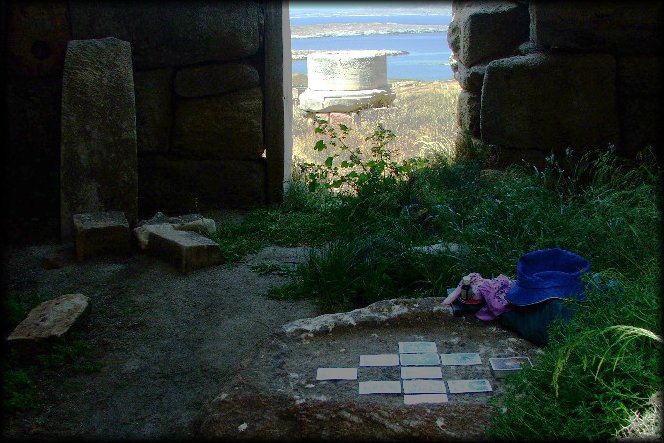
Interior view of the Cave of Cynthos, place of worship of Heracles and Apollo on the Greek island of Delos, photographed May 5, 2005. Digital photo by Eric Francis. But there it stood, millennia later. I had brought along a French edition of the Marseilles tarot, and my German edition of the Crowley/Harris deck (also called Thoth Deck, or Tarot of the Egyptians). Crowley/Harris came out of the bag first and got the job. I used a spread I designed called the Celtic Wings. I recorded the time, 12:21 pm. I did not know it, but the Sun was two arc minutes from the exact midpoint of Taurus -- the moment of Beltane, a solar holiday, as reckoned by solar movement. The Sun was directly overhead and Leo was in the ascendant. A very solar moment, with the Sun at the exact cross-quarter -- the precise distance between equinox and solstice, on the island of the Sun's birth. Choosing the cards, I wafted between that fairly typical sense of mild confusion, 'am I picking the right cards?', and this sense of reaching into the unknown. I looked at them face down for a while. Then, turning over each card, and seeing what it was, came with a sense of clarity and appropriateness I've never quite felt before, as if each card, once revealed, was exactly in its place. Looking at the spread, I could see the path clearly; I could see the issues clearly. It presented a few puzzles, but they unraveled easily. This was not Delphi talking in riddles. I am not saying I understand everything about the spread, but what was presented came across unequivocally, and with a clear message to trust the process. The collective part of the reading, which I've shared separately, was told mainly in four cards: the 9 of swords, the 10 of swords, The Devil and The Star. The 9 and 10 of swords, in my interpretation, deal with fear that is pushed to the mental level, to an extreme. This is not the practical fear one would feel being chased down the street by a dog. This is fear for its own sake, manufactured or the result of spiritual degeneration. The swords appeared in two places: the past, and a place in the spread that describes the larger environment. The past position comes with the reminder that what has happened is still a factor -- a kind of intuitive or body memory. If something appears in a spread, it is still a factor in the situation. This factor is the guilt, cruelty and pain that has been inflicted on humanity, and by people on themselves, and on one another, for countless eons. The activating factor of this cruelty or guilt was shown to be materialism or the material world: The Devil, which was in the position of that which needs to be resisted, what needs to be chosen against, or that which we're somehow struggling with. This includes economic materialism, but it's also a popular relationship style that is based on ownership and imprisonment. In some decks, The Devil is a parody of The Lovers card. How funny the card is, in these decks, should help cast off the fear associated with it -- these goofy looking people chained together, and chained to the guy with horns between them. Crowley skips this and focuses on a magnificent image of a goat with long, twisted horns. And who is this? The Devil, though it can represent a kind of negativity in most interpretations, is neither Satan nor Lucifer; it's really Pan, a powerful, playful nature god who is all about earthiness and fertility. Crowley gives us a big cocky goat with a wreath hung crookedly around his horns. There's also the image of a penis imposed on the goat, which pierces Nut, the goddess-roof of the night. Earth and Heaven connect. Material grounding is entirely necessary to live. So, too, is fertility and Earth and, in truth, everything Pan, the horned, horny god of goats, sheep and flocks, represents. Yet to be whole, Pan must connect with the 'greater cosmos' -- heaven herself. Next to the 9 of swords, there are several implications. One message is that possession or overemphasis on the material world leads to guilt and fear. Yes, how we respond is a matter of choice; yes, it's guilt and cruelty that, in this spread, is depicted as largely in the past. But not for everyone -- and not so very far in the past, which, anyway, is the place most people live. The resounding message of this combination is also that Christianity has made sex and Earth, which quite literally give us life, into 'the devil', and for many, life is one huge guilt trip as a result. Regarding the material nature of the Earth, the body, its needs and its desires, many with spiritual leanings tend to have deeply engrained negative feelings: about sex, about money, even about getting their most basic needs met. The Devil in the position involving 'negative feelings', or that which is being resisted, suggests we need to feel better about materializing and building; and better about our earthly existence -- without making it into God. This setup was clarified by the two cards that portray the environment. The first, directly above The Devil, was The Star. Seeing this card next to the 10, I was reminded of the expression from the Starseed Transmissions, "An island of the future in a sea of the past." The Star is the Aquarius card. It's one of the friendliest cards in all the tarot, with its illustration of the cosmic energy pouring through humanity and into the Earth, saying we and she and all this space are all one living system. It's a card of divine protection and contact. Lady Frieda's version (she was Crowley's illustrator) is particularly amazing, with its crystalline energy seeming to flow from the cosmos and through the goddess Nut (the vault of the heavens), right there on the card. So there was Pan (The Devil) below, with Nut directly above, both in that card and in the card above; a perfect fit, with this sense of Heaven and Earth in contact in both cards, and Nut drawn directly into The Devil card. This says: work on Heaven-Earth contact -- on shifting our awareness around this apparent and rather fraudulent split. The Earth is in heaven because it is in space. There is no division except in our minds. The next card out from The Star, representing the larger environment, was the 10 of swords. This is the 'sea of the past' -- the seeming world of fear in which we live, fear that is supported by the petty projections and arguments and aggressions of many millions of people, and a certain few tsars and warlords who would kill one another for the right to slay the last tree. We don't need to live that way, but to get free, we do need to recognize those thought patterns in their many forms. The Star is a card of enormous protection -- the protection of God and Goddess, the protection of community, and the spirit of love that permeates the cosmos down to the last cell, if we will only let it. It's the card that says we can work together with Spirit to take care of one another. So The Star, quite a cosmic commentary, exists in this environment of abject fear, but is also to a great extent sheltering us from it. The 10, by itself, presents a real dilemma. It's when things have broken down so badly that there seems to be no way out (watch TV lately?). It's the card of the worst kind of impasse, a seemingly intractable situation (remind you of anything personal?). It is the card where fear not just dominates, but seems to be the only thing there is. There is no apparent exit. It's also the end, or rather culmination, of something. It is a 10, after all. It's as if the fear has gone as far as it can; its only option is to consume itself and begin again (1 + 0 = 1). The Grateful Dead aptly summed it up using the line from an old nursery rhyme. The song, 'Throwing Stones', talks about, "A fear down here we can't forget / Hasn't got a name just yet / Always awake, always around / Singin' ashes, ashes, all fall down. Within that fear exists individual consciousness -- and that consciousness, called you and me, has to make a decision.
The Grotto of Heracles spread says focus on the love of community. The Star says get together. The Devil adds: ground yourself, feel good about being human, and get Heaven and Earth together in your own mind. Try not feeling guilty about being alive. Getting together means recognizing how much we are NOT together, and how much we NEED to be together, and then actually taking the simplest steps toward making that happen. Simple, like friends meeting in the Laundromat the same night and doing the laundry. Simple, like making food for one another. The Star talks not of exclusive, closed community, but rather of open, free community. This card is next to the 2 of cups -- love. This 2 is usually personal or interpersonal love; no doubt. Yet the fairly simple message, placed where it was, is that personal relationships exist in the context of community, not as something apart from it. In this spread, The Star and 2 of cups say start building that community close to home, then spread out. Interesting that The Star is surrounded by one card representing love (2 of cups), and another card representing fear (10 of swords). These are the choices we have as a community. As with all things Aquarian, our global technology (the Internet, for example) can, for the moment, bring us closer. But that's not close enough. We need to do better. If we cannot smell one another, the communication is not complete. If we cannot hear one another's voices, we cannot hear. We need to be pretty close to get the pheromone molecules circulating and to hear the real voice and to feel human warmth. No verbal communication is as subtle as body language. Nothing can replace eating together, celebrating together, grieving together, loving together, fucking together, raising our families together, doing business together, or building our world together. We have all but stopped doing these entirely natural things, and have nearly stopped thinking about them; we have all but forgotten, and we need to remember, and begin again, in earnest, even with the world in the state that it is today -- especially so. Because... If the game is lost, More on Mithridates: http://en.wikipedia.org/wiki/Mithridates_VI_of_Pontus More on Delos: http://en.wikipedia.org/wiki/Delos 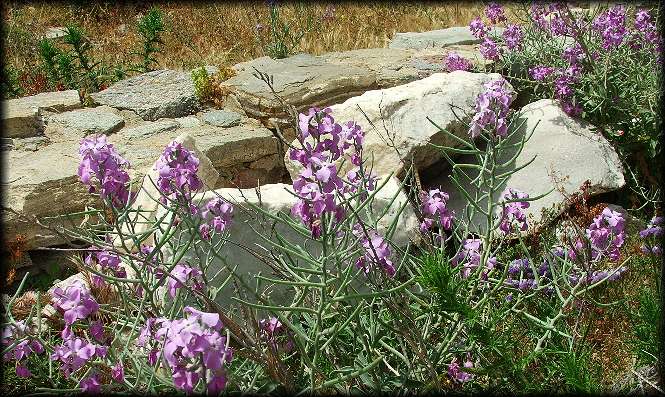
Wildflowers grow among the ruins of Delos. Digital photo by Eric Francis. |
